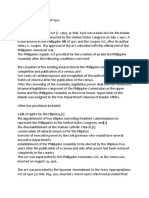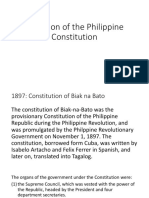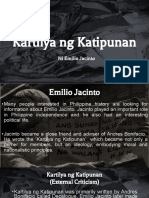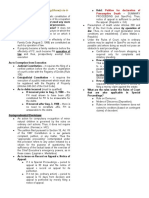0 ratings0% found this document useful (0 votes)
499 viewsPhilippine History
Philippine History
Uploaded by
Candice Bolay-ogThe document discusses the history of colonialism in the Philippines from the arrival of the Spanish in the 16th century through independence in the mid-20th century. It notes that Spanish colonization lasting three centuries left an indelible impression and shaped Philippine culture by combining Asian, European, and American influences. The document also outlines key events in the Philippine revolution including the establishment of the Katipunan revolutionary society and the declaration of independence from Spain in 1898. It notes that while the Philippines gained formal independence, its political and social structures continue to be shaped by the legacy of colonial rule.
Copyright:
© All Rights Reserved
Available Formats
Download as DOCX, PDF, TXT or read online from Scribd
Philippine History
Philippine History
Uploaded by
Candice Bolay-og0 ratings0% found this document useful (0 votes)
499 views2 pagesThe document discusses the history of colonialism in the Philippines from the arrival of the Spanish in the 16th century through independence in the mid-20th century. It notes that Spanish colonization lasting three centuries left an indelible impression and shaped Philippine culture by combining Asian, European, and American influences. The document also outlines key events in the Philippine revolution including the establishment of the Katipunan revolutionary society and the declaration of independence from Spain in 1898. It notes that while the Philippines gained formal independence, its political and social structures continue to be shaped by the legacy of colonial rule.
Original Title
Philippine-History
Copyright
© © All Rights Reserved
Available Formats
DOCX, PDF, TXT or read online from Scribd
Share this document
Did you find this document useful?
Is this content inappropriate?
The document discusses the history of colonialism in the Philippines from the arrival of the Spanish in the 16th century through independence in the mid-20th century. It notes that Spanish colonization lasting three centuries left an indelible impression and shaped Philippine culture by combining Asian, European, and American influences. The document also outlines key events in the Philippine revolution including the establishment of the Katipunan revolutionary society and the declaration of independence from Spain in 1898. It notes that while the Philippines gained formal independence, its political and social structures continue to be shaped by the legacy of colonial rule.
Copyright:
© All Rights Reserved
Available Formats
Download as DOCX, PDF, TXT or read online from Scribd
Download as docx, pdf, or txt
0 ratings0% found this document useful (0 votes)
499 views2 pagesPhilippine History
Philippine History
Uploaded by
Candice Bolay-ogThe document discusses the history of colonialism in the Philippines from the arrival of the Spanish in the 16th century through independence in the mid-20th century. It notes that Spanish colonization lasting three centuries left an indelible impression and shaped Philippine culture by combining Asian, European, and American influences. The document also outlines key events in the Philippine revolution including the establishment of the Katipunan revolutionary society and the declaration of independence from Spain in 1898. It notes that while the Philippines gained formal independence, its political and social structures continue to be shaped by the legacy of colonial rule.
Copyright:
© All Rights Reserved
Available Formats
Download as DOCX, PDF, TXT or read online from Scribd
Download as docx, pdf, or txt
You are on page 1of 2
“History provides us a sense of our own identity”, these statement
left a significant mark on me throughout the duration of this course.
Studying Philippine History is important because you have to understand
and know the things that happened in the past for you to appreciate the
future and present situation of our country. The Philippines has a rich
history beginning from its earliest days. Philippine history is rich in heritage
and culture combining Asian, European and American influences. A period
of Spanish colonization spanning three centuries then made an indelible
impression on the country. This mercurial era, along with the American
occupation, played a vital role in shaping the Philippines and its people.
But is the Philippines truly independent?
Antonio Pigafetta, the assistant of Magellan kept a journal that
became the primary source of information on the first meeting between
Spaniards and Filipinos (Torres, 2018). The Spaniards, headed by
Ferdinand Magellan, were the first Europeans to arrive in the Philippines.
He claimed the islands for Spain on March 16, 1521. It was not easy for
the Spaniards to conquer and build a government in the Philippines
because the native Filipinos fought for their rights, freedom, and dignity.
Fray Juan de Plasencia (Joan de Portocarrero, real name) was a member
of the Franciscan Order who came together with the first batch of
missionaries to the Philippine in 1578. His constant encounters with the
people he converted to Christianity prompted him to write Relacion de las
Costumbres de Los Tagalogs (Customs of the Tagalogs, 1589) where he
vividly portrayed the Filipinos' political, social, economic, and cultural
traditions prior to their conversion to Christianity.
During the colonialism of the Philippines, the Filipinos lost their
freedom and were abused by the Spaniards. The Filipinos became slave
of the Spaniards for a very long time. The first move towards
independence began on July 7, 1892 when the Katipunan was established
by Andres Bonifacio. The Kataastaasang Kagalang-galangngang
Katipunan ng mga Anak ng Bayan or KKK was a revolutionary society that
advocated for the Philippines' independence and freedom through the use
of force. Its goal was to separate the Philippines from Spain while also
allowing Filipinos to flourish as citizens of their own country after
independence was attained. Kartilya a text of Katipunan’s Code of
Conduct written by Emilio Jacinto. It was created not just the rules for the
organization's members, but also the principles for people of a country
once independence was gained.
The first phase of the Philippine Revolution ended in a stalemate
between the Spaniards and the Filipino rebels. In December 1897, a truce
was declared between the two forces with the Filipino leaders, led by Gen.
Emilio Aguinaldo. he truce, however, lasted for only a few months before it
collapsed. By the help of our great men and some Americans, the
Philippines became free from the hands of the Spanish. On June 12,
1898, Aguinaldo declared Philippine Independence from Spanish rule at
ceremony in his house in Kawit, Cavite. And this is the end of the Spanish
regime. The United Stated had a different approach in colonizing the
Philippines. The Americans considered educating the Filipinos as one of
their top priorities in the Philippines. They treated Filipinos like their
friends. The 1935 Constitution and the Commonwealth Government was a
transition government before the granting of the Philippine independence
with American-inspired constitution; the Philippine government would
eventually pattern its government system after American government. The
Commonwealth Government was interrupted by the Second World War
and the Japanese occupation of the Philippines. After the end of the war,
the United States and the Philippines signed the Treaty of Manila on July
4, 1946; Manuel Roxas transitioned from the President of the
Commonwealth of the Philippines to first President of an independent
Philippine Republic.
Despite the fact that the term "independent" implies a Philippines free of
foreign rule, many modern narratives of Filipino identity, citizenship, and
statehood are inextricably shaped by the colonial history and, some argue,
the continuing undue influence of other countries. The political, social, and
economic elites of the country, for example, are often members of the
same families that have held power in the country for generations. as in
the aftermath of Spanish and United States colonialism, Filipinos still
struggle with defining a national identity after such widespread traumas.
Other current issues for the Philippine state include resolving a territorial
dispute with the People's Republic of China over areas of the South China
Sea, as well as allowing the United States troops to return to the islands.
understanding today’s Republic of the Philippines means studying the
historical roots of power and influences born from the imposition of
colonial structures.
You might also like
- A Report On Genocide'Document6 pagesA Report On Genocide'Oliver Aloyce100% (1)
- Post-Colonial Philippines and Australia by Raymund P. Cruz-PhD-ELM-Comparative EducationDocument21 pagesPost-Colonial Philippines and Australia by Raymund P. Cruz-PhD-ELM-Comparative EducationRaymund P. CruzNo ratings yet
- The Role of Think Tank in Us Foreign PolicyDocument47 pagesThe Role of Think Tank in Us Foreign Policysierra_ts100% (2)
- Reform and Revolution in The PhilippinesDocument80 pagesReform and Revolution in The Philippinesfayliza87% (23)
- Ang Kartilya Ni Emilio Jacinto Group 5Document27 pagesAng Kartilya Ni Emilio Jacinto Group 5Sarah Quijan BoneoNo ratings yet
- Reaction Paper (Actofproclamation)Document1 pageReaction Paper (Actofproclamation)Michael AngelesNo ratings yet
- Ge02 CHP 4 l1 Monastic Supremacy in The Philippines Merged CompressedDocument73 pagesGe02 CHP 4 l1 Monastic Supremacy in The Philippines Merged CompressedJacoba, Michaela JasmineNo ratings yet
- Consti 2 1973-CONSTITUTIONDocument10 pagesConsti 2 1973-CONSTITUTIONRandom internet personNo ratings yet
- Philippine AssemblyDocument3 pagesPhilippine AssemblyJerome EncinaresNo ratings yet
- WalkingDocument4 pagesWalkingJay Lester UrsolinoNo ratings yet
- Philippine Organic Act of 1902Document5 pagesPhilippine Organic Act of 1902Lizza AlipioNo ratings yet
- Chinese in The PhilippinesDocument56 pagesChinese in The Philippinesalice rodejeroNo ratings yet
- The Constitution of The Philippine CommonwealthDocument3 pagesThe Constitution of The Philippine Commonwealtheydel_beeNo ratings yet
- Francisco FrondaDocument2 pagesFrancisco FrondaAva Barrameda100% (1)
- Act of Declaration of IndependenceDocument67 pagesAct of Declaration of IndependenceGerard Byron Jacildo100% (1)
- Pagka MakataoDocument18 pagesPagka MakataoLiana Rose MeregildoNo ratings yet
- 1935 ConstitutionDocument25 pages1935 ConstitutionJustine BayhonNo ratings yet
- Evolution of The Philippine Constitution 1Document35 pagesEvolution of The Philippine Constitution 1Jerlyn LotoNo ratings yet
- Reading in Philippine History: (Kataastaasang Kagalang-Galangang Katipunan NG Mga Anak NG Bayan or KKK)Document5 pagesReading in Philippine History: (Kataastaasang Kagalang-Galangang Katipunan NG Mga Anak NG Bayan or KKK)Angel AngelesNo ratings yet
- A Hitherto Unpublished Document On The Landing of Magellan at HomonhonDocument5 pagesA Hitherto Unpublished Document On The Landing of Magellan at HomonhonManuelito 'Manwell' ÜyNo ratings yet
- 1899 Malolos ConstitutionDocument8 pages1899 Malolos ConstitutionMa. Rowena FloresNo ratings yet
- Crusade or CommerceDocument6 pagesCrusade or CommercejjjNo ratings yet
- Evolution of The Philippine ConstitutionDocument10 pagesEvolution of The Philippine ConstitutionIrish Sashane SatiniamanNo ratings yet
- Iskolar NG BayanDocument1 pageIskolar NG BayanmengkymagubatNo ratings yet
- Filipino American RelationsDocument20 pagesFilipino American Relationsgustokongmaginghatdog2.1100% (2)
- The Constitution of The Philippine CommonwealthDocument11 pagesThe Constitution of The Philippine CommonwealthBJ AmbatNo ratings yet
- Corazon Aquino's Speech Before The Joint Session of The United StatesDocument8 pagesCorazon Aquino's Speech Before The Joint Session of The United StatesMarese PrietoNo ratings yet
- Ninoy Aquino Speech Reaction PaperDocument1 pageNinoy Aquino Speech Reaction Paperjohnny100% (1)
- RIPH QUIZ Controversies On The Site of The First MassDocument7 pagesRIPH QUIZ Controversies On The Site of The First MassLyra Via MagnoNo ratings yet
- Assimilation of The Philippines Into The Spanish RuleDocument5 pagesAssimilation of The Philippines Into The Spanish RuleMitch Forbes100% (2)
- Readings in Philippine HistoryDocument32 pagesReadings in Philippine HistoryAileen MalanaNo ratings yet
- "One Past But Many Histories" Controversies and Conflicting Views in Philippine HistoryDocument4 pages"One Past But Many Histories" Controversies and Conflicting Views in Philippine HistoryRAGOS Jeffrey Miguel P.No ratings yet
- Constitution of The PhilippinesDocument11 pagesConstitution of The PhilippinesRonald GuevarraNo ratings yet
- Corazon Aquino SpeechDocument17 pagesCorazon Aquino SpeechricoliwanagNo ratings yet
- The Campaign For Independence (1922-1935)Document25 pagesThe Campaign For Independence (1922-1935)Via Escribano PacilunaNo ratings yet
- The TeacherDocument71 pagesThe TeacherMicheleNo ratings yet
- Understanding The Self ReviewerDocument7 pagesUnderstanding The Self ReviewerIan Jay MacaraegNo ratings yet
- The Revolution of 1896Document41 pagesThe Revolution of 1896addictingwallflowerNo ratings yet
- What Is Preamble and Its Features?Document4 pagesWhat Is Preamble and Its Features?Chloie Marie RosalejosNo ratings yet
- NSTP 1 Packet 3Document37 pagesNSTP 1 Packet 3Alnessa Christa OsnanNo ratings yet
- Taxation During The Commonwealth PeriodDocument23 pagesTaxation During The Commonwealth PeriodcarolreynnNo ratings yet
- Timeline of Spanish Colonization of The PhilippinesDocument14 pagesTimeline of Spanish Colonization of The PhilippinesAaron Jolo AlcantaraNo ratings yet
- "Declaration of Philippine Independence": by Ambrosio Rianzares BautistaDocument29 pages"Declaration of Philippine Independence": by Ambrosio Rianzares BautistaRommel Soliven EstabilloNo ratings yet
- The Constitution of The Philippine CommonwealthDocument11 pagesThe Constitution of The Philippine CommonwealthBJ AmbatNo ratings yet
- Ideal Self and Real SelfDocument2 pagesIdeal Self and Real SelfAUPAssocLegdeleonNo ratings yet
- Reading in Philippine History: Editorial Cartoons As Historical MainspringDocument2 pagesReading in Philippine History: Editorial Cartoons As Historical MainspringJefferson SociasNo ratings yet
- Lesson7 Raidersofsulusea: Readings in Philippine HistoryDocument41 pagesLesson7 Raidersofsulusea: Readings in Philippine HistorySuper M'barekNo ratings yet
- Lesson 2 THE PHILIPPINES IN THE 19TH CENTURYDocument17 pagesLesson 2 THE PHILIPPINES IN THE 19TH CENTURYkrismaevelNo ratings yet
- Religious Orders in The PhilippinesDocument14 pagesReligious Orders in The PhilippinesjaybeeNo ratings yet
- Kartila NG Katipunan-Lesson 2.3Document30 pagesKartila NG Katipunan-Lesson 2.3Emmanuel El Gibor AlmarioNo ratings yet
- Course Learning OutcomesDocument3 pagesCourse Learning OutcomesPat RiciaNo ratings yet
- THE 1935 Constitution: Yannel M. VillaberDocument12 pagesTHE 1935 Constitution: Yannel M. VillaberYannel Villaber100% (1)
- Syllabus GE 2 Readings in Philippine History BEEDDocument9 pagesSyllabus GE 2 Readings in Philippine History BEEDveehneeNo ratings yet
- Philippine History 101 Assignment: AnswerDocument7 pagesPhilippine History 101 Assignment: AnswerRoschelle MiguelNo ratings yet
- Chapter 4 SummaryDocument6 pagesChapter 4 SummaryGrace Tejano Sacabin-AmargaNo ratings yet
- CristobalDocument16 pagesCristobalJamie LiwanagNo ratings yet
- 1986 Freedom ConstitutionDocument4 pages1986 Freedom ConstitutionIrin200100% (2)
- 2.9. Commission On Independence, Filipino Grievances Against Governor Wood (ZAIDE, 11. PP. 230-234) - (PETITION LETTER)Document4 pages2.9. Commission On Independence, Filipino Grievances Against Governor Wood (ZAIDE, 11. PP. 230-234) - (PETITION LETTER)Zhane LabradorNo ratings yet
- Malolos Constitution QUIZDocument1 pageMalolos Constitution QUIZAmira B TarusanNo ratings yet
- On Philippine Revolts and RevolutionDocument32 pagesOn Philippine Revolts and RevolutionJr Ocampo100% (1)
- Module Intro To Philo 1Document26 pagesModule Intro To Philo 1Candice Bolay-ogNo ratings yet
- Module Sla 4 6 Buhionjjohaira P. Grade12 JadeDocument16 pagesModule Sla 4 6 Buhionjjohaira P. Grade12 JadeCandice Bolay-ogNo ratings yet
- FIRST QUARTER Math Answer SheetsDocument7 pagesFIRST QUARTER Math Answer SheetsCandice Bolay-ogNo ratings yet
- Sla Eim 12 Week 5 Non Metallic Sheated Cable NmnmcnmsDocument2 pagesSla Eim 12 Week 5 Non Metallic Sheated Cable NmnmcnmsCandice Bolay-og0% (1)
- Blue Isometric Elements Mockups Technology in Education Technology Presentation 2Document9 pagesBlue Isometric Elements Mockups Technology in Education Technology Presentation 2Candice Bolay-ogNo ratings yet
- Sla Eim 12 Week 4 Flexible Armored CableDocument2 pagesSla Eim 12 Week 4 Flexible Armored CableCandice Bolay-og100% (1)
- Name: - Score: - Year/Course: - DateDocument10 pagesName: - Score: - Year/Course: - DateCandice Bolay-ogNo ratings yet
- Ice Breaker: - O - EY M - K - T I - ST - U - EN - SDocument14 pagesIce Breaker: - O - EY M - K - T I - ST - U - EN - SCandice Bolay-ogNo ratings yet
- Commercial Paper, Banker's Acceptance, Eurodollars: Prepared By: Jannica Aila Marie A. BalariasDocument10 pagesCommercial Paper, Banker's Acceptance, Eurodollars: Prepared By: Jannica Aila Marie A. BalariasCandice Bolay-ogNo ratings yet
- SchedulingDocument11 pagesSchedulingCandice Bolay-ogNo ratings yet
- Sumobay OM FinalsDocument4 pagesSumobay OM FinalsCandice Bolay-ogNo ratings yet
- EU Law Lecture 1 - IntroductionDocument25 pagesEU Law Lecture 1 - IntroductionsaminaNo ratings yet
- Liberian Daily Observer 01/13/2014Document16 pagesLiberian Daily Observer 01/13/2014Liberian Daily Observer NewspaperNo ratings yet
- Lb. Engleza: Universitatea Din Craiova Facultatea de DreptDocument6 pagesLb. Engleza: Universitatea Din Craiova Facultatea de DreptBaitoiu George-MariusNo ratings yet
- Bar Lawsuit Filed Against Utah Gov. Gary HerbertDocument18 pagesBar Lawsuit Filed Against Utah Gov. Gary HerbertAdam ForgieNo ratings yet
- Article XI 1987 Philippine ConstitutionDocument3 pagesArticle XI 1987 Philippine Constitutionreseljan100% (1)
- 47-Ruiz Vs Drilon 209 SCRA 695Document5 pages47-Ruiz Vs Drilon 209 SCRA 695enan_intonNo ratings yet
- Difference Between Issue and ProblemDocument2 pagesDifference Between Issue and ProblemPablo Jan Marc Filio100% (1)
- NCC Camp ProformaDocument2 pagesNCC Camp ProformaAnand Singh0% (2)
- EAF India Recruitment - V6 0Document7 pagesEAF India Recruitment - V6 0Ravipr PaulNo ratings yet
- Sek 20 Award 18280Document16 pagesSek 20 Award 18280Salam Salam Solidarity (fauzi ibrahim)100% (1)
- Foreign Policy of PakistanDocument14 pagesForeign Policy of PakistanSteve MartinNo ratings yet
- York County Prison Hires Controversial Contractor C-SAU For $120,000Document9 pagesYork County Prison Hires Controversial Contractor C-SAU For $120,000Allegheny JOB WatchNo ratings yet
- Duff v. Prison Health Services, Inc. Et Al (INMATE2) - Document No. 6Document2 pagesDuff v. Prison Health Services, Inc. Et Al (INMATE2) - Document No. 6Justia.comNo ratings yet
- COA - 98-002 - Prohibition Against Employment by Local Government Units of Private Lawyers ToDocument3 pagesCOA - 98-002 - Prohibition Against Employment by Local Government Units of Private Lawyers ToYan Rodriguez DasalNo ratings yet
- Ambil vs. SandiganbayanDocument2 pagesAmbil vs. SandiganbayanGia DimayugaNo ratings yet
- Uttara University: Assignment OnDocument3 pagesUttara University: Assignment OnISRAT JAHAN BADHON Spring 19No ratings yet
- SpecPro NotesDocument6 pagesSpecPro NotesaverellabrasaldoNo ratings yet
- United States Court of Appeals Tenth CircuitDocument14 pagesUnited States Court of Appeals Tenth CircuitScribd Government DocsNo ratings yet
- Win & ShineDocument9 pagesWin & Shinem.preethiNo ratings yet
- Gamboa Vs Teves (2012)Document3 pagesGamboa Vs Teves (2012)jdg jdgNo ratings yet
- DEED OF ABSOLUTE SALE-motor Vehicle SCDIDocument2 pagesDEED OF ABSOLUTE SALE-motor Vehicle SCDIJosEs-Men100% (1)
- Ayres Statement of OffenseDocument6 pagesAyres Statement of OffenseDaily KosNo ratings yet
- Be It Enacted by The Senate and House of Representatives of The Philippines in Congress AssembledDocument6 pagesBe It Enacted by The Senate and House of Representatives of The Philippines in Congress Assembledsamdelacruz1030No ratings yet
- History of The Scottish Episcopal ChurchDocument638 pagesHistory of The Scottish Episcopal ChurchPAUL KAY FOSTER MACKENZIE100% (2)
- All India Service (AIS) ManualDocument844 pagesAll India Service (AIS) ManualRajiv Ranjan100% (2)
- CIR V Mindanao SanitariumDocument2 pagesCIR V Mindanao SanitariumcarolNo ratings yet
- Guia de Bibliografia de Las Elites PDFDocument179 pagesGuia de Bibliografia de Las Elites PDFCerisimaNo ratings yet
- Ijhesm 019Document15 pagesIjhesm 019Gowthami R shettyNo ratings yet




































































































